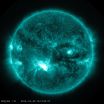Online dermatologic follow-up for atopic dermatitis earns equivalent results
2014-10-22
(Press-News.org) An online model for follow-up care of atopic dermatitis (eczema) that gave patients direct access to dermatologists resulted in equivalent clinical improvement compared to patients who received traditional in-person care writes author April W. Armstrong, M.D., M.P.H., of the University of Colorado, Denver, and colleagues.
There are not enough dermatologists in the United States to meet the demand for services. Teledermatology is a chance to improve access to care.
The authors conducted a one-year randomized controlled equivalency trial that included adults and children with atopic dermatitis who had access to the Internet, computers and digital cameras. The study included 156 patients: 78 patients visited dermatologists at their offices for follow-up care, while the remaining 78 patients accessed care online, which included electronically transmitting clinical pictures to dermatologists who evaluated them, provided treatment recommendations and prescribed medications. The severity of the atopic dermatitis was measured by patient-oriented eczema measure (POEM) and investigator global assessment (IGA).
Between baseline and 12 months, the average difference in POEM score in patients in the online group was -5.1 and -4.86 in the in-person follow-up group. The percentage of patients achieving clearance or near clearance of their atopic dermatitis (IGA score of 0 or 1) was 38.4 percent in the online group and 43.6 percent in the in-person group.
"Health services delivery in dermatology is an exciting and evolving field. With the changing health care environment and a growing demand for dermatologic services, technology-enabled health care delivery models have the potential to increase access and improve outcomes. ... As with any novel health services delivery models, comparative effectiveness studies investigating health outcomes are critical to evaluate these new models in an evidence-based approach.
INFORMATION:
JAMA Dermatology. Published online October 22, 2014. doi:10.1001/jamadermatol.2014.2299. Available
Editor's Note: This work was supported by an Agency for Healthcare Quality and Research award to an author. Please see the article for additional information, including other authors, author contributions and affiliations, financial disclosures, funding and support, etc.
To contact author April W. Armstrong, M.D., M.P.H., call Mark Couch. An author podcast will be available when the embargo lifts on the JAMA Dermatology website: http://bit.ly/1eFUc6O
ELSE PRESS RELEASES FROM THIS DATE:
2014-10-22
Cognitive behavioral therapy with exposure therapy (CBT/exposure), where patients relive the experience of a death of a loved one, resulted in greater reductions in measures of prolonged grief disorder (PGD) than CBT alone.
PGD involves persistent yearning for the deceased and the associated emotional pain, difficulty in accepting the death, a sense of meaninglessness, bitterness about the death and difficulty in engaging in new activities. To diagnose PGD, the symptoms need to last at least six months. PGD is distinct from depression because of a person's preoccupation ...
2014-10-22
A few short years ago, the idea of a practical manufacturing process based on getting molecules to organize themselves in useful nanoscale shapes seemed ... well, cool, sure, but also a little fantastic. Now the day isn't far off when your cell phone may depend on it. Two recent papers emphasize the point by demonstrating complementary approaches to fine-tuning the key step: depositing thin films of a uniquely designed polymer on a template so that it self-assembles into neat, precise, even rows of alternating composition just 10 or so nanometers wide.
The work by researchers ...
2014-10-22
While studying the atmosphere on Saturn's moon Titan, scientists discovered intriguing zones of organic molecules unexpectedly shifted away from its north and south poles. These misaligned features seem to defy conventional thinking about Titan's windy atmosphere, which should quickly smear out such off-axis concentrations.
"This is an unexpected and potentially groundbreaking discovery," said Martin Cordiner, an astrochemist working at NASA's Goddard Space Flight Center in Greenbelt, Maryland, and the lead author of a study published online today in the Astrophysical ...
2014-10-22
Researchers from the University of Texas Medical Branch at Galveston, University of Kentucky, and University of Maryland found that for people 60 and older who do not have dementia, light alcohol consumption during late life is associated with higher episodic memory — the ability to recall memories of events.
Moderate alcohol consumption was also linked with a larger volume in the hippocampus, a brain region critical for episodic memory. The relationship between light alcohol consumption and episodic memory goes away if hippocampal volume is factored in, providing ...
2014-10-22
The sun erupted with another significant flare today, peaking at 10:28 a.m. EDT on Oct. 22, 2014. NASA's Solar Dynamics Observatory captured images of the event, which occurred in the lower half of the sun. This flare is classified as an X1.6 class flare. X-class flares denote the most extreme flares. This is the third substantial flare from the same region of the sun since Oct. 19.
INFORMATION:
To see how this event may affect Earth, please visit NOAA's Space Weather Prediction Center at http://spaceweather.gov, the U.S. government's official source for space weather ...
2014-10-22
Invasive seaweed shelters native crustacean
On the tidal mudflats of Georgia and South Carolina, the red Japanese seaweed Gracilaria vermiculophylla is gaining a foothold where no native seaweeds live. Only debris and straggles of dead marsh grass used to break the expanse of mud at low tide. Crabs, shrimp, and small crustaceans mob the seaweed in abundance. What makes it so popular? Not its food value. On mudflats near Savannah, Ga., Wright and colleagues found that the tiny native crustacean Gammarus mucronatus (one of the 9,500 species of amphipod, which includes sand ...
2014-10-22
New maps of Saturn's moon Titan reveal large patches of trace gases shining brightly near the north and south poles. These regions are curiously shifted off the poles, to the east or west, so that dawn is breaking over the southern region while dusk is falling over the northern one.
The pair of patches was spotted by a NASA-led international team of researchers investigating the chemical make-up of Titan's atmosphere.
"This is an unexpected and potentially groundbreaking discovery," said Martin Cordiner, an astrochemist working at NASA's Goddard Space Flight Center ...
2014-10-22
An interdisciplinary team of researchers from the University of Texas Medical Branch, and Winship Cancer Institute of Emory University have identified small molecules that can represent a new class of anticancer drugs with a novel target for the treatment of lung cancer. These findings are detailed in Nature Communications. A PCT patent (WO 2013028543 A1) was jointly documented by these two Institutes for the invention.
Survival outcomes remain poor for lung cancer patients in large part because of lung cancer's resistance to conventional therapies. Programmed cell death, ...
2014-10-22
While space debris was the uncontrolled adversary in the award-winning space thriller film "Gravity," space debris, also known as "space junk," is an ongoing real-life concern for teams managing satellites orbiting Earth, including NOAA-NASA's Suomi National Polar-orbiting Partnership, or Suomi NPP, satellite. It is not unusual for satellites that have the capability of maneuvering to be repositioned to avoid debris or to maintain the proper orbit.
On an otherwise quiet Sunday on September 28, the Suomi NPP mission team was monitoring a possible close approach of a debris ...
2014-10-22
Many cancer patients use dietary supplements such as vitamins, minerals and herbs or other botanicals but often don't tell their doctor.
This gap in communication can happen when patients believe that their doctors are indifferent or negative toward their use of these supplements. As a result, patients may find information about dietary supplements from unreliable sources, exposing themselves to unneeded risks. Since information on these dietary supplements is limited, researchers from the University of Texas Medical Branch describe a practical patient-centered approach ...
LAST 30 PRESS RELEASES:
[Press-News.org] Online dermatologic follow-up for atopic dermatitis earns equivalent results




